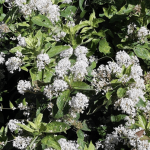We often get questions on what sort of edible plants can be found in Florida’s natural lands. This week in the Plant Clinic, Master Gardener and Master Naturalist Don Philpott (dp@mediawiseus.com) gives a lesson on what’s brewing in your yard! Read Don’s other articles [here].
Whose for tea?
For early pioneers and settlers, tea and coffee were expensive commodities and even to get fresh supplies could mean hours or even days to the nearest store. So, our ancestors looked to the woods and the fields for plants that could provide cheap and acceptable drink alternatives.
Three hundred years ago, the first English and Spanish settlers had no shortage of plants to choose from and today you can still make refreshing and interesting drinks from nature’s larder.

One of those plants is redroot (Ceanothus americanus) which has a large root used by Native Americans to make red dye, thus its name. The leaves contain ceanothine which makes a good substitute for China tea. The plant became very popular after the British levied a tax on imported tea and many people switched to the substitute until the tax was repealed. In the northeast, the plant is still called New Jersey Tea.

Sassafras (Sassafras albidum), also common in central Florida, has long been used to make homemade root beer and used to be a main ingredient of commercial root beer until it was banned because it contains safrole, which when fed to rats in massive doses could cause liver cancer. Scientists have since pointed out that alcohol in beer is over ten times more likely to cause cancer than safrole in root beer. You can also make a tea from the crushed leaves, letting them steep for a few minutes in boiling water and then straining out the leaves.
Refreshing, fragrant teas can also be made from boiling the young twigs of spicebush (Lindera benzoin) which is more common in north Florida although can be found in Central Florida. The leaves of goldenrod (Euthamia caroliniana) make a tea with an anise-like fragrance, while two or three leaves of yaupon holly (Ilex vomitoria) soaked in hot water make an invigorating drink often called cassena or the black drink.
The red berries of sumac soaked in two or three changes of water make an acidic, refreshing drink that is often called Indian lemonade. There are many species of sumac and all those that have red berries are edible.
A little more punch

For something with a little more kick there are beers made from dandelions, nettles, yarrow, blue porterweed and mugwort, a member of the Artemisia family. You can also make elderflower champagne and country wines from a host of fruits, berries and even fungi.
Homemade beers and wines have been produced – and enjoyed – for centuries but they are now becoming big business. In the last three years the number of local craft and microbreweries in the U.S. has increased by over 15 percent to almost 5,000. Many of these are offering both traditional and “foraged” beers using local ingredients.
At the vanguard of this movement is the Scratch Brewing Company, a remote farmhouse brewery five miles outside rural Ava, Illinois, which in 2016 published The Homebrewer’s Almanac: A Seasonal Guide to brewing with 36 different plants. The brewery has an ever rotating selection of styles enhanced by the innovative addition of local ingredients, such as nettle, elderberry, ginger, dandelion, maple sap, hickory, lavender, juniper, and chanterelle mushrooms.
I never needed to be persuaded that drinking in moderation was fine, but when you are drinking beers and wines made from plants, flowers and wild herbs you can also claim their medicinal benefits as well. Many of these plant-based products are known to aid digestion, strengthen the immune system and fight off colds and other ailments. What better reason do you need for a little imbibing? Cheers.
Contact the Plant Clinic
The Seminole County Master Gardener Plant Clinic is open Monday – Friday from 9am-Noon and 1pm-4pm. For more information on how to contact a Master Gardener about your gardening questions, visit our website at this [LINK].
 0
0
